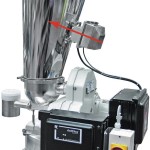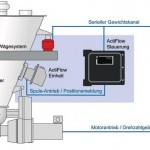Many bulk materials, especially fine powder, do not flow consistently out of the supply hopper during feeding. This can lead to the formation of rat holes, or in extreme cases material bridges. Until now, K-Tron has used a vertical agitator to prevent the occurrence of such problems. Although this system is dependable, it is also difficult to clean and requires additional headroom. These disadvantages can now be avoided with the ActiFlow system.
Dr. Manuel Spoerri
A rat hole is a narrow, vertically oriented tunnel from the top of the material bed in the hopper to the discharge device of the feeder. Although material can continue to flow through these holes, the discharge rate of the feeder is considerably lower and material deposits may remain in the hopper for an indefinite amount of time. Material bridges similarly restrict the flow of material through the feeder. Since bridges lack even the vertical tunnel of a rat hole, however, the material flow tends to be completely blocked. In the past, a vertical agitator was commonly used in K-Tron feeders. On the one hand, this solution is very reliable but on the other, it also has several disadvantages such as significant cleaning effort and additional headroom. The ActiFlow reliably prevents the formation of bridges with even the most poorly flowing materials. It essentially consists of three components: the ActiFlow device on the hopper, the ActiFlow control module and the KCM feeder control module.
The ActiFlow device gently activates the material in the hopper with an optimised amplitude and frequency, while the KCM in combination with the ActiFlow control module ensures that there is always an optimal material flow in the hopper. This provides good feeding accuracy. The filter algorithms in the Smart Force Transducer (SFT) load cells effectively filter out vibrations, thus guaranteeing an exact weight signal at all times – even when the ActiFlow’s activation of the bulk material is at maximum.
The ActiFlow is distinguished by high feeding accuracy for the entire system. The material hopper is made of stainless steel. No contact takes place between the ActiFlow and the feed material, so that no special cleaning is necessary. An additional advantage is that no extra headroom is needed above the hopper. The material in the hopper is neither compacted nor me-chanically overstressed.
In the set-up shown here, the ActiFlow device is attached to the rear of the hopper. The red arrow shows the direction of hopper activation. The position and direction of activation have been optimised during many feeder trials in the laboratory in order to minimise their effect on the weighing system and at the same time maximise the flow of bulk material.
Act instead of react
The most important concept underlying the ActiFlow system is to act instead of react. The feeder control module has the ability to recognise deteriorating material flow in the hopper before a possible mass flow error occurs. In this situation, the ActiFlow increases the activation of the material in the hopper and prevents feedrate errors. When the control module determines that the material flow in the hopper has returned to normal, the ActiFlow reduces the activation of the material again. The ActiFlow only activates the material in the hopper as much as necessary and not as much as possible. A patent-pending control algorithm was developed to facilitate this behaviour. A sensor integrated into the ActiFlow is an additional distinctive feature that functions as a positioning feedback device for the control module. The activation amplitude and frequency can thus be monitored and regulated precisely.
Equipment start-up
Once the equipment is securely installed, two steps are necessary for commissioning. To ensure that the ActiFlow runs reliably and uses energy efficiently, the resonant frequency of the entire system has to be determined. The hopper should be filled with material up to the upper limit. When the feeder is started up, a short frequency search is performed and the resonant frequency that is found is saved. In addition, a material flow property that only has to be estimated once (easy, medium or hard) must be defined in the feeder’s KCM control module. This setting specifies a lower limit for the ActiFlow’s activation of the material in the hopper. Once the equipment is operating, no further inputs are necessary; from this point on, the ActiFlow self-adjusts. If the feed material is changed, both commissioning steps must be repeated.
Two versions of the ActiFlow device are available: the ActiFlow Standard and the ActiFlow Pharma/Food. With the ActiFlow Standard, the cover and the mounting device for attachment to the hopper are made of stainless steel while the base of the ActiFlow is made of coated cast aluminium. With the ActiFlow Pharma/Food, both the cover and the base with the integrated mounting device are made of stainless steel. The surfaces are inclined on this version in order to allow better fluid run-off during cleaning. The two types can be installed in different hazardous areas, depending on the version. The basic version can be used for all standard applications as well as in Atex Zone 22. The Atex version is suitable for all applications up to Atex Zones 1 and 21.
Successful applications
The ActiFlow has been operating successfully in four different industrial applications – three in the plastics industry and one in pharmaceuticals. At Ciba Kaisten AG in Switzerland, for example, the ActiFlow is used in combination with a twin screw feeder with a 180 l hopper, where it has replaced a conventional vertical agitator. Various feeding materials are used, such as Irganox 1010. The feeder is located in the back infeed area of a Bühler twin screw extruder that produces customer-specific additives for plastics manufacturing. Mike Fricker from Ciba is very satisfied with the ActiFlow (see box).
Online-Info www.cpp-net.com/2309430


cpp: Mr. Fricker, you have been using the ActiFlow in your production line since January 2008. What is your opinion?
Fricker: Very positive. It is my hope that the vertical agitator will be replaced with the new device in all feeders.
cpp: What advantages do you see in the ActiFlow compared to the vertical agitator?
Fricker: The feeding is definitely better. Even with a vertical agitator, fluctuations during feeding cannot be ruled out. With the ActiFlow, the material discharge is very constant. In addition, with a vertical agitator, there is still material left in the hopper after running empty. Cleaning is likewise much easier with the ActiFlow. The laborious removal of the vertical agitator is no longer necessary.
cpp: Where do you still see weaknesses?
Fricker: With certain materials, residues sometimes remain on the upper part of the container (material surface) due to the hopper wall vibration. These can be manually removed with a plastic scraper. The lower part of the container is always clean, however.
cpp: In which areas has the changeover to the new system had the most effect?
Fricker: With some products, the maximum discharge of the feeder is significantly higher than with a vertical agitator. This can allow the line output of the extruder to be increased, sometimes up to 50 %. In addition, there are fewer interruptions, for example with poorly flowing products. The ActiFlow prevents bridge formation more reliably than the vertical agitator.
cpp: Has everyday production changed since the migration?
Fricker: We have fewer interruptions due to poorly flowing products. All difficult materials are now fed using the ActiFlow, because we know there will be no problems.
Share:








